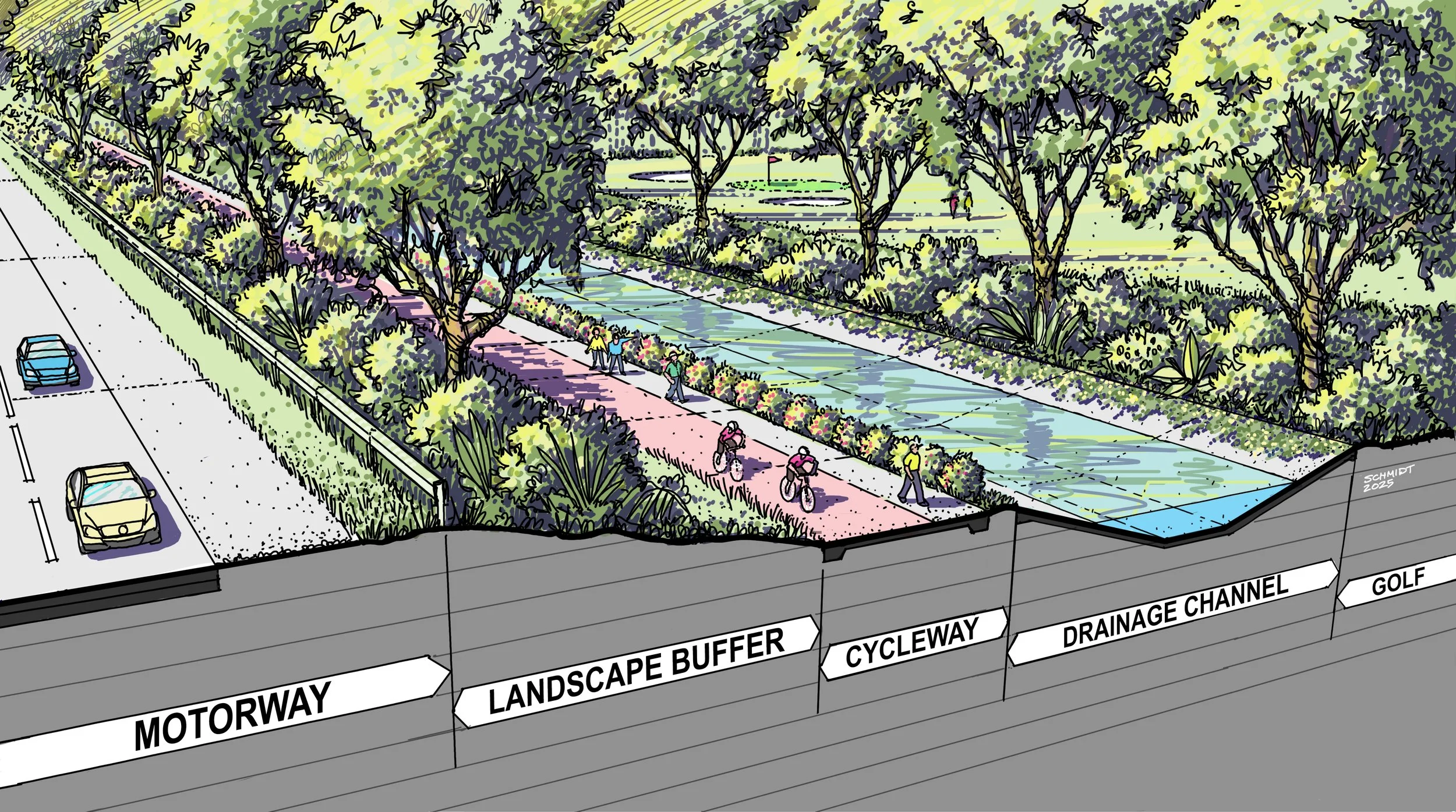What is The SHOAL BAY SOLUTION?
It’s a practical, environmentally friendly plan designed to deliver lasting flood resilience for the Wairau Valley - SMARTER and more cost-effective than other options. It works by safely redirecting stormwater through a landscaped green channel and underground pipe system. This route follows the Takapuna Golf Course, goes under Northcote Road, then passes beneath Smith’s Bush and the motorway before reaching Shoal Bay.
Why does it win over wetlands?
It provides stronger flood protection for the community faster – it can be built in months, not years
It’s a more cost effective solution than anything else put forward and it delivers far greater value for the community and ratepayers
It preserves the natural environment, saving hundreds of trees and important natural ecological areas.
It safeguards valued community assets, such as the 18-hole public golf course, for continued use by future generations of all ages
It eliminates the need for a large artificial wetland at AF Thomas Park, avoiding the environmental impacts and long-term maintenance issues associated with artificial wetlands.
Wait, there’s more…
Sedimentation and water quality
The SHOAL BAY SOLUTION takes into account sedimentation and water quality, by providing Sediment Forebays, designed to slow down and filter stormwater runoff as it makes it’s way to the mangroves and Shoal BayTechnical viability and environmental fit
Preliminary reviews of the site’s ecology, geography, geology, and basic engineering indicate that the proposal from Auckland Council’s Healthy Waters team to create artificial wetlands presents numerous uncertainties, both in terms of feasibility and performance. For example, they have not considered back-to-back flooding events, these is no evidence of an allowance for basalt rock and there is no evidence that they’ve undertaken geotechnical investigations to know how their artificial wetland will work.Cost risks and maintenance burden
There is growing unease around escalating and undefined costs related to design, construction, and long-term maintenance of the artificial wetland infrastructure. These concerns include the presence of basalt rock in the location of the wetland that has been dismissed as falling within 'unforeseen ground conditions'.We believe this plan offers a more sustainable, culturally appropriate, and cost-effective outcome.
Why The SHOAL BAY SOLUTION
is SMARTER
Reliable future-proofing for flood events upstream and downstream – directing water away from endangered people and property.
The total cost for Stage 1 and Stage 2 of the Healthy Waters plan is around $154.6M of which government will pay only $36M leaving over $118M to be paid for by the ratepayers. (This excludes reinstating any recreational use once the earthworks are completed).
The SHOAL BAY SOLUTION is estimated to cost slightly less than Council’s Stage 1 solution, but maintains a revenue stream and reduced ongoing operational costs for Council and ratepayers.
Council still needs to allocate more than $100m of ratepayers money to complete the Stage 2 works, to gain the basic benefits of reducing “high danger flood risk” and “habitable floor flooding” by a total of 18 dwellings as identified in the Healthy Waters Business Case..
Reduced long-term maintenance and capital costs. The Golf Course pays for all its ongoing costs.
Minimised land disturbance, without heavy earthworks, and retains the tree landscape. MANY HUNDREDS of trees will be SAVED from felling.
SAVES EXISTING HABITATS
Keeps vital recreational community assets intact, ensuring ongoing commercial revenue for Auckland Council.
The Shoal Bay Solution is scalable - the Council will later have the option to take even more load off the Milford area by installing a larger pipe or adding a second pipe. By providing a second outlet The SHOAL BAY SOLUTION system would be even more resilient, in the event of flooding, or if the Wairau Stream became blocked.
With the savings The SHOAL BAY SOLUTION offers, a solution could be installed for the Eventfinda stadium to significantly reduce the risk of flooding and ensure this ratepayer owned asset would be insurable again. This is far better than the current HEALTHY WATERS scheme that states ‘the flood waters would only reduce by 100mm - AFTER Stage 2 of their proposal’
The HEALTHY WATERS option is effectively a scorched-earth policy for the entire golf course with virtually every tree and existing stream ecology destroyed, to make way for wholesale excavation and retention of the diggings on site.
The Healthy Waters costing currently does not allocate budget to complete the required Stage 2 works, with Council needing to find more than $100m (of ratepayers money as central government will not contribute to Stage 2) just to gain the basic benefits of reducing flooding by 100mm. Our scheme will achieve all of that for less than a third of the HEALTHY WATERS estimate
HEALTHY WATERS has numerous costs that have been omitted or ignored – for example they have no allowance for reconfiguring the golf course or any other usable landscaping scheme for the public after their huge earth works programme. A new golf course could easily cost another $15-20M – whereas our scheme, with minimal disruption to the existing golf course. does not have this required additional cost
Due to the greatly reduced scale of The SHOAL BAY SOLUTION, the scheme can be delivered and working for the public well ahead of the proposed Stage 1 plus Stage 2 Healthy Waters plan.
Visualisation: Thomas Schmidt, Sepia Design
Check out the NEW costs to ratepayers
The SHOAL BAY SOLUTION - delivers greater long term value.
It really is a “no-brainer”
MANGROVES are amazing!
A quick GOOGLE search finds this brief summation:
Yes, mangroves provide numerous environmental benefits. They act as natural barriers against coastal erosion and storm surges, filter pollutants from water, and play a crucial role in carbon sequestration. Additionally, they offer vital habitats for a diverse range of species and support coastal communities.
Here’s a more detailed look at their positive impacts:
1. Coastal Protection:
Mangroves’ intricate root systems stabilize shorelines, reducing erosion from waves, tides, and currents. Their dense vegetation can buffer the impact of storm surges and tsunamis, protecting coastal communities and infrastructure.
2. Water Quality Improvement:
Mangroves filter pollutants, excess nutrients, and sediment from stormwater runoff before they reach seagrass beds and coral reefs. Their roots help trap sediment and other pollutants, preventing them from polluting nearby marine ecosystems.
3. Climate Change Mitigation:
Mangroves are highly effective carbon sinks, storing significantly more carbon per unit area than terrestrial forests. By storing carbon in their biomass and the sediment beneath them, mangroves help reduce atmospheric carbon dioxide levels.


